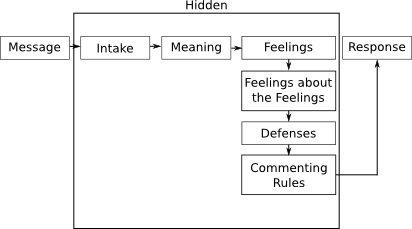It all started with a tweet I posted:
“Why” questions trigger feelings bypassing data input and thinking. #dontdothat
As this got retweeted, interesting questions started coming my way:
- What about the Five Whys?
- Do you have data?
- What is your context?
All good questions.
“Why” questions have the ability to both gather data and to probe for underlying thoughts and decisions that lead to action. Other interrogatives (what, when, where, how) provide a better way to gather data since they focus on physical items or actions.
So when do “Why” questions work well? How might “Why” questions lead to unexpected results? What can we do about that?
Solving Problems: Toyota and the Five Whys
I was writing process control code for a living when I first heard about the Five Whys. It made sense for finding a problem’s root cause. The example went something like this:
- Why did the line stop? Because the conveyor gear reduction box froze.
- Why did the gear reduction box freeze? Because it didn’t get lubricated during the last preventive maintenance.
- Why didn’t it get lubricated during the last maintenance? It’s a new piece of equipment and wasn’t on the preventive maintenance check list.
- Why didn’t it get added to the maintenance check list when it was installed? Because we don’t have a standard way of adding items to the check list.
- How can we create a standard way of adding items to the check list so this won’t happen again?
Asking why uncovers another layer of information that eventually leads to the problem’s root cause and allows us to craft a solution to (hopefully) prevent the problem. Since we’re starting with observable data, asking why works well here.
Gathering Data: Five-year-old Whys
Anyone who has spent time around children has probably experienced a period of incessant whys.
Why is the sky blue? Because air molecules scatter light from the sun.
Why do the air molecules scatter the light? Because they get in the way of the sun’s rays.
Why do they get in the way?
(And so on.)
Often, the question-and-answer process ends with “Because I said so, that’s why.”
Asking why provides children with new information, and data expands their knowledge, so why works well here – at least until “Because I said so.”
When Why Might Not Work Well
Your teammates, managers, and coworkers are neither mechanical processes, which don’t care if we talk about them, nor five-year-olds attempting to gather more information about their world. They come complete with experiences you don’t know about and ideas about how things should work. As such, your why questions may trigger in others an emotional response that catches you unaware. What might generate such a response?
An Interaction Model
The Satir Interaction Model [1] provides a framework for understanding how interactions proceed, as shown in figure 1.
Figure 1
Take Tony, for example. You’ve noticed the build server has been sending emails announcing that the build broke, and Tony usually makes the commit that occurred just before the build that broke. Wanting to be helpful, you head to Tony’s cube and ask, “Why do you keep breaking the build?” You’re looking for information. The message has been spoken and becomes the input.
Based on how Tony feels and his background, he can infer several different meanings. He may think you’re picking on him. He may think you mean “Tony, you’re incompetent.” He may interpret the question as a request for information.
The meaning Tony chooses determines his feelings about your message. If he thinks you’re picking on him, perhaps he will feel afraid or threatened. If he believes you think he’s incompetent, he might become defensive, or he might be relieved that you might help with the problems he’s having.
Tony also will have feelings about those feelings based on his background. Perhaps his father taught him not to back down when threatened, or to prove you’re right when challenged, or even that accepting help shows weakness. Tony may feel ashamed, angry, confused, or relieved.
Based on Tony’s life experiences, he may defend himself by:
- Blaming – “The stupid formatting rules take too long to check. If IT would buy us better computers, this would not happen.”
- Placating – I’m so stupid. I should do better.”
- Being super-reasonable – “Has anyone checked the rules on the build server to make sure they agree with how the builds work on my workstation?”
- Feigning irrelevance – It’s almost lunch. Where should I go today?”
After these steps, Tony will work on his response. What can he safely say? What do his family, social, and corporate cultures say about what he can say? Some comments can be career limiting. Does he have an “always be agreeable” rule? These commenting rules affect his verbal response.
Everything between the Intake and Response steps happen internally for Tony, but you can guess what happens based on his response. If Tony replies in a way congruent with your intention “I’m having problems with formatting. Can you help me figure out what’s happening?” the request for information succeeded. If Tony becomes bellicose, belligerent, or his answer bewilders you, the question triggered a meaning and feeling not related to your request for information.
The Interaction Model and Temperaments
In Congruent Action [2] Gerald M. (Jerry) Weinberg collapses the steps from Feelings through Defenses into a single step, which he calls Significance, and correlates how Keirsey’s Temperaments [3] (see the sidebar) tend to work through the Interaction Model:
- SJs stay in Intake mode too long.
- NTs tend to go instantly to Meaning.
- NFs tend to jump immediately to Significance.
- SPs go so fast it looks to others as if they jump instantly to Response.
More than half of IT professionals implicitly skip the Intake step based on their personality preference. You want to know “why” to collect data – 41.6 percent will look for the meaning behind your question and another 12.1 percent think about how the question makes them feel.
Jerry offers the following suggestions:
- For NTs/NFs, ask, “What did you see or hear that led you to that conclusion?”
- For SJs, ask, “What can we conclude from the data we have so far?”
- For SPs, appeal to their desire to be clever and ask them to teach you how they did it.
Use Data Questions to Gather Data
Questions that start with other interrogative words, such as when, what, where, and how, help people focus on the data aspect of the question.
If we ask Tony a different question, we can help him focus on the data we would like to know—for example, “What steps do you take prior to committing to the build server?” or “How do you decide it’s time to commit your code?” Tony still traverses the Interaction Model, but we’ve explicitly asked for data.
Over the years, I’ve had some why questions bounce back to me with responses that left me wondering how what I said triggered that response. Using the Satir Interaction Model, I’ve learned to unravel the responses. I’ve also learned that if I want data, I should use data-oriented questions that start with how, what, when, and where, and use why as a last choice.
On the other hand, if you want practice unraveling communications, start with why as often as possible.
[SIDEBAR]
Temperaments
“There are two types of people: people who divide people into two types and those who don’t.” – Barth’s Distinction
Dividing people into groups is a time-honored tradition. Circa 340 BC, Plato divided people into four groups: Artisans, Guardians, Idealists, and Rationals. Since then, many others, including Aristotle, Galen, Paracelsus, Fromm, and Myers, have found ways to divide people into four groups.
In 1978, David Keirsey and Marilyn Bates developed and described the temperaments in modern form. They found that selectively combining [N with T/F and S with J/P] produced a descriptive personality system similar to the four temperaments … described centuries earlier. [4]
| Temperament | Motivation | Strengths | Weaknesses | Percentage in IT Profession |
| Guardian / SJ | Need to be responsible Value tradition |
Reliable Organized Focused Conscientious |
Judgmental Controlling Inflexible Close-minded |
22.6 |
| Artisan / SP | Need for freedom and action Value being in the moment |
Optimism Adventurous Realistic Adaptable |
Hyperactive Impatient Impulsive Scattered |
9.5 |
| Rational / NT | Need knowledge and competency Value theory and mind |
Innovative Inquisitive Analytical Independent |
Arrogant Cynical Critical Distant |
41.6 |
| Idealist / NF | Need to understand themselves and others Value authenticity and integrity |
Compassionate Warm Helpful Idealistic |
Hypersensitive Overly emotional Impractical Unrealistic |
12.1 |
“When the only tool you have is a hammer, it is tempting to treat everything as if it were a nail.” – Abraham Maslow
I like to remind clients that temperaments represent one way of understanding people and how they interact.
References
- The Satir Model: Family Therapy and Beyond, 1991, Science & Behavior Books, Inc., pp 121-129
- Quality Software Management, Volume 3, Congruent Action, 1994, Gerald M. Weinberg, pp 108-109
- Please Understand Me II, 1998, Prometheus Nemesis Book Company
- MBTI Manual: A Guide to the Development and Use of the Myers-Briggs Type Indicator, 2003, Isabel Briggs Myers and Mary H. McCaulley
- From What Type Am I? Discover Who You Really Are, 1998, Renee Baron
- From the Myers-Briggs Type Indicator Atlas of Type Tables, Macdaid, McCaulley, and Kainz, CAPT, 1985
This article was originally posted on StickyMinds.com on January 28, 2011 © 2011 Don Gray



Don, I enjoyed reading the post. I agree that using the five whys out of context is likely to have a poor outcome.
My understanding is that the five why technique is used by a team to think together about the system behaviour and to seek a root cause of a problem. In the Lean context, there is safety, trust and mutual purpose.
– Michael
Michael, I agree with you about the five whys (hopefully) leads to discovering a problem’s systemic root cause.
I agree when and where safety, trust and mutual purpose exist asking “Why” looking for that root cause can work well.
The article points to using interrogatives other than why when looking for data. This starts conversations at a data level similar to the second step Esther/Diana’s retrospective structure: Gather Data. Once we have data, then we can work on insights and root causes.
Does this make sense?
for me, the way the five why’s was designed, was to find that same data.
yet without fixing order in the questions…